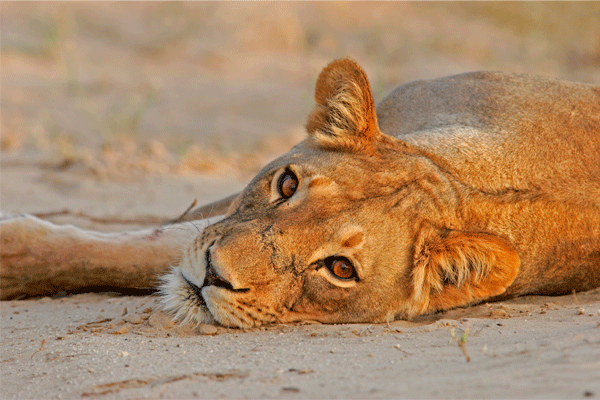By 1983, lion expert Professor Eloff and his colleagues had spent over 10 years with the lions of the Kalahari; marking them and tracking them in order to gain the valuable insight that has been so ardently translated to his reading audience. In his book, The Hunters of the Dunes, Eloff has painted admirable portraits of a small selection of the individuals and the alliances he met during his 30 year stint under Africa’s harsh sun. In previous instalments of this series, we have been introduced to Kromvoet of Gharagab, the Sisters Gang and the lion lover, Haaslip; all of which have described very characterful individuals and extraordinary pride dynamics. While reading up on my latest Dune King, I was intrigued by the subtlety of this lioness and I was surprised that on completion of my research, I had not read about terrorising attacks or eyes ablaze with anger. Her reverent title made sense to me at the end; she was strong and silent and she persevered with grace and patience, and these were the reasons this single lioness impressed on Eloff’s heart, despite the very short time they spent together. She is the latest of the Kalahari Dune Kings: The Champion Lioness.
Her striking beauty and tender age made her a sure target. A fine female of four years at the most made her a perfect mate for a pride leader. She would have had sisters, a mother, or possibly a cub of her own, surely. After over a decade of ploughing through the ruby red sand, studying padded tracks before the gusting wind disguised them in the dunes, Eloff’s team of researchers had not come across this lioness. Immediately, she was a magnet of interest and the well-practiced land rover sniffed out her tracks and followed her movement. Where was the pride she belonged to? It is not uncommon to see tufty-maned males setting off solo, after losing a battle for dominance and leaving their childhood prides; however, a lone female was less common. What would the harsh Kalahari conditions have in store for a single female?
Perhaps they were looking for an explanation as to why she didn’t belong to a pride, but the team picked up in her behaviour that she was inexperienced, an impulsive youth. She didn’t possess the stealth nor the quickness of other lionesses, and maybe that was why she had fallen behind.
One night, not long after this first encounter, the mysterious female introduced a dashing male on a visit to the waterhole situated at the team’s camp. A quiet couple, unperturbed by the presence of humans; a behaviour unlike that of the aggressive Sisters Gang that had relentlessly stalked the campsite in the dead of the desert night. The morning following this tranquil midnight meeting, the couple was found under a shepherd’s tree, proudly protecting an infant cub. A small bundle of mewling, blinking, tawny fur lay between the good looking pair; barely a week old. This small family dozed in the dappled shade until nightfall when mother and father set off on a hunt. The result was dismal and the next day Eloff’s hungry, young mother returned to her cub, dutifully suckling despite her lack of energy. Her male companion set off over the dune and was not seen again.

The name given to her in the Hunters of the Dunes is undoubtedly drawn from the characteristics demonstrated in the week following her abandonment by her mate. Her persistent, yet fruitless hunts were heart-wrenching to read about. This young female covered distances of up to fifty kilometres a night, stalking low to the ground and breaking into tiresome sprints, which, when she was clearly desperate, stretched on for four hundred metres. Gemsboks, bat-eared foxes, aardvarks, steenboks and hartebeests existed in abundance in the Kalahari – some of these species often falling victim to lion-play, as egotistic kings of the desert bullied and clawed these innocent creatures to pass the time. Even these tormented animals outwitted and outpaced this inexperienced lioness.
It was with will in their hearts that the avid trackers observed her many failed chases, and with encouraging congratulations that they applauded her mere two successes. Each time her prey was a weakened calf; not a respectable achievement for a lion.
Over the six days and nights the Champion Lioness was followed, Eloff recorded that she returned to her cub a few times to feed him, never forgetting her responsibility as a mother. After a measly steenbok meal, Eloff’s special lioness returned to the shepherd’s tree, calling softly to the young cub who would be hungrily waiting to suckle. On approach, it was obvious that something was wrong. Blood stained the sand where her baby had slept and the investigative tracks of a jackal circled the tree. Finally bearing milk to feed, finally gaining the strength to return to her den, the Champion Lioness had left it too long. The team’s Bushman tracker expertly tracked the jackal’s movements, leading them to the devastating site of a badly buried lion cub. Eloff himself admitted to feelings of anthropomorphia, as he watched the unusual female disappearing over a dune, not before lingering in what could only be interpreted as sadness before slinking off for good.


